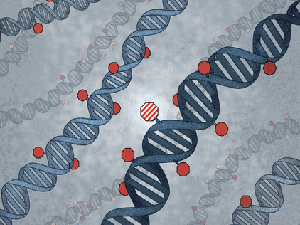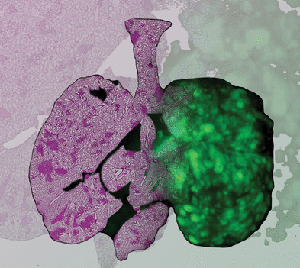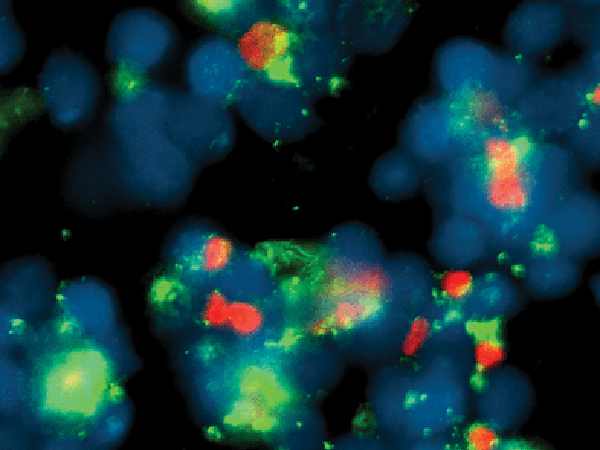Editors Share Highlights From the AACR Journals
Each month, the editors of the nine AACR journals select one article from each issue to highlight. The featured articles for September described the preclinical evaluation of a new ALK inhibitor, the development of a deep learning algorithm to identify driver methylation events, and provided insight into breast cancer metastasis.
As always, the highlighted articles are freely available online for a limited time.
Journal: Cancer Discovery
Discovery of Candidate DNA Methylation Cancer Driver Genes

Aberrant DNA methylation is common in a variety of cancer types. While DNA methylation changes occur throughout the genome, only a subset of these will lead to cancer. In this article, the authors report the development of MethSig, a deep learning algorithm designed to distinguish oncogenic driver methylation events from benign passenger events. MethSig utilizes gene-specific methylation, gene expression, replication timing, and background methylation rates to identify driver methylation events. The authors validated their algorithm using bisulfite sequencing data from patients with chronic lymphocytic leukemia, multiple myeloma, ductal carcinoma in situ, and glioblastoma, as well as methylation array data from 18 different tumor types. MethSig showed greater sensitivity and specificity than previous methods and could also predict patient outcomes. Deletion of select DNA methylation drivers identified by MethSig provided a fitness advantage in preclinical experiments. The authors conclude that MethSig provides a novel tool to identify DNA methylation drivers in order to study the role of aberrant DNA methylation in cancer. This article is highlighted and featured on the cover of the September issue. This research was also presented at a session co-sponsored by the AACR at the International Conference on Malignant Lymphoma and described in a recent blog post.
Journal: Clinical Cancer Research (September 1 issue)
In human cells, DNA damage is sensed by the protein kinases ATM and ATR, which activate cell cycle checkpoints and DNA repair mechanisms. Because tumor cells often accumulate significant DNA damage, inhibition of these kinases can cause genomic instability and cell death. Ceralasertib is a selective ATR inhibitor shown in preclinical studies to synergize with paclitaxel chemotherapy. In this phase I clinical trial, the researchers treated 57 patients—33 of whom had immunotherapy-resistant melanoma—with paclitaxel plus one of the various doses of ceralasertib. Patients were given 80mg/m2 paclitaxel on days one, eight, and 15 of each 28-day treatment cycle, in addition to a dose of ceralasertib, ranging from 40 mg daily to 240 mg twice a day. The researchers determined the recommended phase II dose of ceralasertib to be 240 mg twice a day on days one through 14 of each treatment cycle. The most common toxicities of grade three or higher were neutropenia (30 percent), anemia (23 percent), and thrombocytopenia (9 percent), but the maximum tolerated dose was not reached before dose escalation was halted. Responses to treatment included one complete response (melanoma), 12 partial responses (10 with melanoma), and 18 patients with stable disease (eight with melanoma). These data suggest that ceralasertib is an effective and well-tolerated therapeutic option when used in combination with paclitaxel, especially for patients with treatment-refractory melanoma. This study was highlighted in the September 1st issue.
Journal: Cancer Prevention Research
Immune Responses Vary in Preinvasive Colorectal Lesions by Tumor Location and Histology
Immune cell infiltration and antitumor immune responses correlate strongly with prognosis in many tumor types, including colorectal cancer. However, few studies have examined the immune landscape of precancerous colorectal lesions, or how immunologic features affect the likelihood that such a lesion will become cancerous. In this study, the researchers used immunofluorescent staining to identify populations of mast cells, helper-T cells, and natural killer cells, as well as the cytokines IL-6, IL-17A, and IFN-γ, in 101 precancerous colorectal lesions. They found that all immune markers except IL-17A were more commonly found in lesions from the proximal colon than the distal colon and rectum, suggesting that lesions deeper in the colon may be more immunologically “cold.” Lesions with a higher degree of dysplasia had, on average, fewer mast cells, but similar staining of all other immune markers. However, lesions with increasingly villous histology—typically associated with more aggressive characteristics— were marked by decreasing numbers of all immune markers studied. These data highlight the heterogeneity of the immune microenvironment of various precancerous colorectal lesions and could lead to the identification of new therapeutic targets. This study was featured on the cover of the September issue.
Journal: Molecular Cancer Research
While immunotherapy—such as antibodies inhibiting the immune checkpoint proteins PD-1 and PD-L1—has become a mainstay of treatment for several advanced tumor types, it does not benefit all patients. Combining immunotherapy with other drugs has improved outcomes for some patients, but many tumor types lack biomarkers to help identify which patients may benefit from which combinations. In this study, the researchers evaluated the efficacy of combining lenvatinib, a kinase inhibitor primarily targeting VEGFR and FGFR, with pembrolizumab, an anti-PD-1 antibody, in patients with renal cell carcinoma, using data from a phase Ib/II clinical trial. They also investigated potential biomarkers that correlated with improved response in these patients. Of the 24 patients enrolled in the trial, 19 experienced a partial response, four experienced stable disease, and only one experienced progressive disease. Sequencing of tumor tissue revealed that tumor mutational burden was not associated with clinical response, although it is used as a biomarker for PD-1 monotherapy in other tumor types. Germline sequencing, however, revealed that high genotypic diversity of HLA-I proteins, which present antigens on the surface of tumor cells, was associated with a significantly longer progression-free survival, likely owing to the ability to present a more diverse selection of tumor antigens for immune system activation. The study authors suggest that, once optimized, HLA-I genotyping could provide valuable insights into which patients may respond to combination immunotherapy and kinase inhibitors. This article was highlighted in the September issue.
Journal: Cancer Immunology Research
Chronic inflammation caused by colitis can facilitate the development of colorectal cancer. In this study, the authors investigated whether the neurotransmitter 5-hydroxytryptamine (5-HT) has a role in colitis-associated colorectal cancer because it has been reported to promote gastrointestinal inflammation. They found biosynthesis and secretion of 5-HT was increased in mouse and human colorectal cancer when compared with normal colorectal epithelial cells. Binding of 5-HT produced by colorectal cancer cells to its receptor HTR3A on macrophages enhanced activation of the NLRP3 inflammasome, which is a multiprotein complex that can trigger the production of pro-inflammatory cytokines including interleukin-1β (IL-1β). Release of IL-1β by the macrophages stimulated further production of 5-HT by colorectal cancer cells, demonstrating the existence of a vicious circle between 5-HT and inflammasome activation
in the tumor microenvironment. The authors evaluated the therapeutic potential of targeting 5-HT biosynthesis or HTR3A by both small hairpin RNA silencing and pharmacological inhibition. Each of these approaches reduced tumor growth and progression in mouse models of colorectal cancer, and combining both approaches had a more substantial effect, suggesting that targeting the positive feedback loop between 5-HT and inflammasome may represent a potential therapeutic strategy for colorectal cancer. This study was featured on the cover of the September issue.
Journal: Cancer Research (September 15 issue)
Chronic injury and inflammation are recognized as key driving factors in the development of hepatocellular carcinoma (HCC), one of the most common forms of liver cancer and currently the third leading cause of cancer deaths worldwide. In this study, the authors dissected the role of IL-6, a cytokine involved in pro-inflammatory signaling pathways, in the development of HCC, using a mouse model that lacks the Mdr2 gene. This model recapitulates the patterns of chronic injury associated with hepatitis in human patients and leading to development of HCC. Inactivation of the IL-6/Stat3 signaling in Mdr2 knockout mice using three different genetic strategies caused aggravated liver injury with increased dysplastic nodule formation, accelerated tumorigenesis and significantly reduced senescence — one of the most important tumor suppressive mechanisms in the prevention of neoplastic transformation, which was accompanied by increased hepatocyte proliferation. These findings suggest that IL-6 may play opposing, context-dependent functions, promoting tumorigenesis when associated with acute tissue loss and regeneration, and suppressing it in the context of chronic injury and senescence. This article was featured in a commentary in the same issue.
Journal: Blood Cancer Discovery
Bortezomib Induces Anti–Multiple Myeloma Immune Response Mediated by cGAS/STING Pathway Activation
The proteosome inhibitor bortezomib causes cell death in multiple myeloma cells and is used as a treatment for this disease. In this study, the authors used mouse models of multiple myeloma to study the effects of bortezomib on immune activation. They observed that bortezomib induced immunogenic cell death (ICD), which led to multiple myeloma-targeted immunity and long-term clinical responses. In addition, they found that a bortezomib-specific ICD gene signature was associated with improved outcomes in patients. Further analysis revealed that bortezomib-induced ICD occurred through the cGAS/STING pathway, which led the authors to examine the impact of combining a STING agonist with bortezomib. They found that this combination led to greater ICD and enhanced immunity against multiple myeloma in preclinical models. The authors propose clinical evaluation of bortezomib in combination with a STING agonist for the treatment of multiple myeloma. The article is highlighted in the September issue, and a related commentary can be found here.
Journal: Molecular Cancer Therapeutics
Anaplastic lymphoma kinase (ALK) inhibitors have been used for the treatment of a small subset of patients with non-small cell lung cancer (NSCLC) since 2011, when crizotinib, the first molecule of this class, was approved. Although each new generation of ALK inhibitors showed improvements in potency and in the ability to reach the central nervous system, they are still affected by therapy resistance due to the emergence of ALK mutations that interfere with drug binding. This study described a new inhibitor called TPX-0131, designed to reduce its sensitivity to a broad range of ALK drug-resistant mutations. TPX-0131 potently inhibited the enzymatic activity of wild type ALK and a wide spectrum of mutants and caused complete tumor regression in mouse models carrying ALK mutations. Additionally, further preclinical studies demonstrated a high level of CNS penetration, suggesting this drug has the potential to cross the blood-brain barrier in humans, an important feature in the treatment of patients with ALK mutations who have a higher risk of brain metastases. This article was featured among this issue’s highlights.
Journal: Clinical Cancer Research (September 15 issue)
BRCA1 or BRCA2-mutated breast cancers have deficient DNA damage repair that makes them sensitive to treatment with Poly(ADP-ribose) polymerase (PARP) inhibitors and platinum agents. Two PARP inhibitors have been approved so far for the treatment of breast cancer. The BROCADE3 trial tested a third PARP inhibitor called veliparib in combination with carboplatin and paclitaxel in HER2-negative advanced breast cancer patients with BRCA1 or BRCA2 mutation. Patients progressing on placebo plus carboplatin and paclitaxel were eligible to switch to veliparib monotherapy. The study presented in this article analyzed the safety and efficacy of crossover veliparib and evaluated the utility of biomarkers in predicting response. The authors reported that 16 percent of the 50 patients with measurable disease in the veliparib crossover group had partial response (PR), and the clinical benefit rate, or the total fraction of patients who had complete response, PR or stable disease, was 30.5 percent at 24 weeks. The most frequent adverse events were nausea, vomiting, and fatigue. Activity directly correlated with duration of response to prior platinum-based therapy (platinum-free interval, PFI) as responses were observed in 23.1 percent of patients with PFI longer than six months versus 13.5 percent of patients with PFI shorter than six months. Secondary BRCA mutations that partially restored protein function, or reversion mutations, were observed infrequently, but their presence may promote cross-resistance and limit PARP inhibitor efficacy after platinum failure. These data suggest that prior platinum treatment does not preclude use of a PARP inhibitor in patients with BRCA-associated advanced breast cancer if they are considered platinum sensitive, and that BRCA reversion testing may help to identify which platinum-treated patients could be considered candidates for PARP inhibitor therapy. This article was featured among this issue’s highlights.
Journal: Cancer Epidemiology, Biomarkers & Prevention
Cancer Facts & Figures is an annual publication that projects the number of new cancer cases and deaths in the United States for the upcoming year. Every five to eight years, the American Cancer Society and the National Cancer Institute collaborate to assess and update the methods used to generate these projections. Here, the authors evaluated multiple prediction models, including the currently used county-level model developed in 2012 (M0), a state-level mixed effect model (M1), and two state-level hierarchical Bayes models with varying random effects (M2 and M3). They assessed the ability of each model to fit incidence data from 1996-2014 for 16 different cancer sites. The accuracy of each predictive model was measured by determining the average absolute relative deviation (AARD), with a lower AARD indicating better prediction. The AARD ranged from 2.8-33.0 percent for M0, 3.3-31.1 percent for M1, 6.6-30.5 percent for M2, and 10.4-393.2 percent for M3. M1 had the fewest technical issues in terms of model convergence and running time. Based on these factors, the authors conclude that M1 is the most accurate and efficient model. This article is highlighted in the September issue.
Journal: Cancer Research (September 1 issue)
A Wnt-1 Independent LGR4-EGFR Signaling Axis in Cancer Metastasis

LGR4 and its family members, LGR5 and LGR6, help maintain stem cell function, but their aberrant expression or activation can promote tumorigenesis and metastasis. These factors are thought to elicit their effects by stabilizing Wnt receptors, thereby enhancing Wnt signaling. The authors of this study provide evidence, however, that LGR4 may drive tumor metastasis using a Wnt-independent mechanism. They found that neither pharmacological inhibition of Wnt secretion, genetic disruption of Wnt production, nor mutation of LGR4 to prevent its interaction with Wnt cofactors blocked the ability of LGR4 to promote the migration and invasion of breast cancer cells. By screening for other signaling pathways disrupted by LGR4 knockdown, the researchers found that LGR4 can stimulate EGFR activation in cell line models of breast, prostate, and lung cancer. They found that LGR4 directly binds to EGFR, preventing its degradation and thereby amplifying EGFR signaling. These data demonstrate a new mechanism by which LGR4 may promote metastasis, which could lead to a better understanding of how Wnt and EGFR signaling independently mediate metastatic processes. This study was featured on the cover of the September 1st issue, and a related commentary can be found here.



